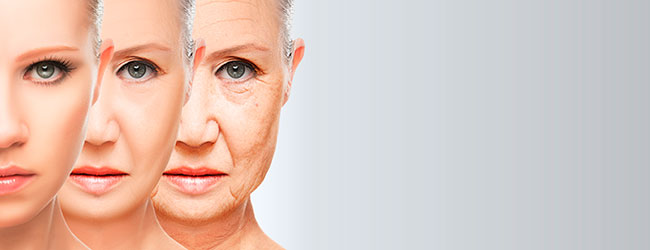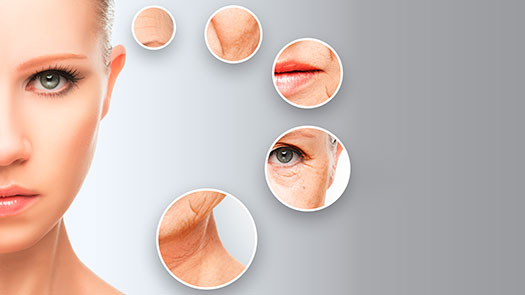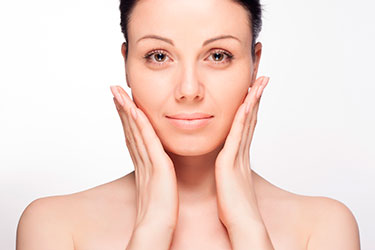Skin aging is a complex, progressive and irreversible biological process. It is conditioned by the individual genetic factors (approximately 25%), as well as nutritional and environmental factors.
It involves a number of changes affecting the epidermal cell turnover, the thickness of the dermis, the operation of the sebaceous and sweat glands, thermoregulation, immune response and a large set of processes at cellular level.


They give rise to the “intrinsic or chronological aging”: genetically determined, they affect the skin and all other organs through a slow and irreversible decline.
It is a set of clinical and physiological changes that occur with age and affect the epidermal cell turnover, the thickness of the dermis, the ability of thermoregulation and healing, immune response, sensory perception, the production of sweat and sebaceous glands, and the synthesis of vitamin D.
It is an individual cellular process that alters the tissues progressively inducing: gradual loss of intrinsic pigmentation, dryness, epidermal atrophy and alterations of the dermal connective tissue, decreased subcutaneous tissue, fine wrinkles which tend to improve once the skin stretches, loss of skin elasticity (especially in post-menopausal women) and more obvious expression folds.
The extrinsic factors not only accelerate and intensify the chronological skin aging processes, but also introduce qualitative changes.
These factors act on the skin causing visible morphological alterations and others which are evident on a functional level.
The key to dealing with all of them is prevention.
The most important extrinsic factor is the ultraviolet radiation (UVA and UVB).
It is manifested by functional and structural changes in the exposed areas: face, neck, chest, forearms, ears, legs, back of the hands and scalp when hair is scarce.
The degree of photo-aging depends on the amount and quality of the absorbed ultraviolet radiation, various climatic factors, genetic factors of the subject, the skin tone and quality of DNA repair mechanisms.
At external level some patches and deeper wrinkles often appear and do not fade when stretching the skin. Infrared rays also affect photo-aging skin.
Epidemiological studies confirm that the risk of wrinkles in women smokers is almost triple compared to those who do not smoke and twice as much than in men smokers.
The human skin is exposed to the smoke effects in direct contact with the skin, and indirectly by the arrival of toxic substances via blood from the smoke inhaled.
Smoke causes premature wrinkles (decreased hydration of the face stratum corneum), dry hair and dry skin.
Tobacco’s biological effects include: an increase in free radicals that damage cell membranes, premature skin aging and decreased tissue oxygenation.
These changes usually occur after the age of 35 and are directly proportional to the degree of consumption, with finer and deeper wrinkles on the face than those of non-smokers, a yellowish/greyish face skin tone and a drying out of the skin and hair, which become brittle and lose brightness.
Alcohol produces premature aging, opacity and drying of the skin.

Hot air, cold and seasonal changes cause aging and dryness of the skin.

An unbalanced diet, and especially a diet rich in saturated fats, causes alterations in the lipid metabolism of the skin, affecting its proper health.

Stress alters significantly the skin accelerating its aging process.
It affects sleep, causing the skin to lose freshness.
It causes the appearance of patches because it makes it more vulnerable to the environment.
It also causes wrinkles and hair loss; it is also believed to be the cause of early greying.
Diseases such as psoriasis, certain drugs (tretinoin against acne) and some medical treatments such as radiation also cause dryness and aging of the skin.
In these cases, monitoring and treatment guidelines should be performed by the doctor.

External signs
The most important visible signs are wrinkles and dryness.
With aging and external factors, the skin becomes dry because it loses its natural lipids and the surface skin barrier degrades preventing moisture retention. The skin is perceived as tight and rough.
In cases of extreme dryness, skin may experience discomfort such as itching or a scaly look, becoming cracked especially in flexing areas during motion.

Care
It is important to follow a few guidelines to minimize factors:
- Outdoors, avoid wherever possible the dry, cold or very hot air.
- Reduce sun exposure and always use sunscreen of high SPF value.
- Avoid long baths and very hot water. Quick showers using mild soaps are recommended to avoid dragging skin lipids.
- Protect the hands from cold and harsh detergents. Wear gloves if necessary.
- Maintain a good level of hydration using moisturizers with active substances and antioxidants that restore the balance of the skin, in order to help minimizing the transepidermal water loss and counteract the effects of aging. Avoid ingredients such as alcohol or perfume, since dry skin may be more prone to irritation.
- Maintain a balanced diet and drink enough water. Avoid alcohol and smoking.
- Maintain a healthy lifestyle eliminating stressors wherever possible.

